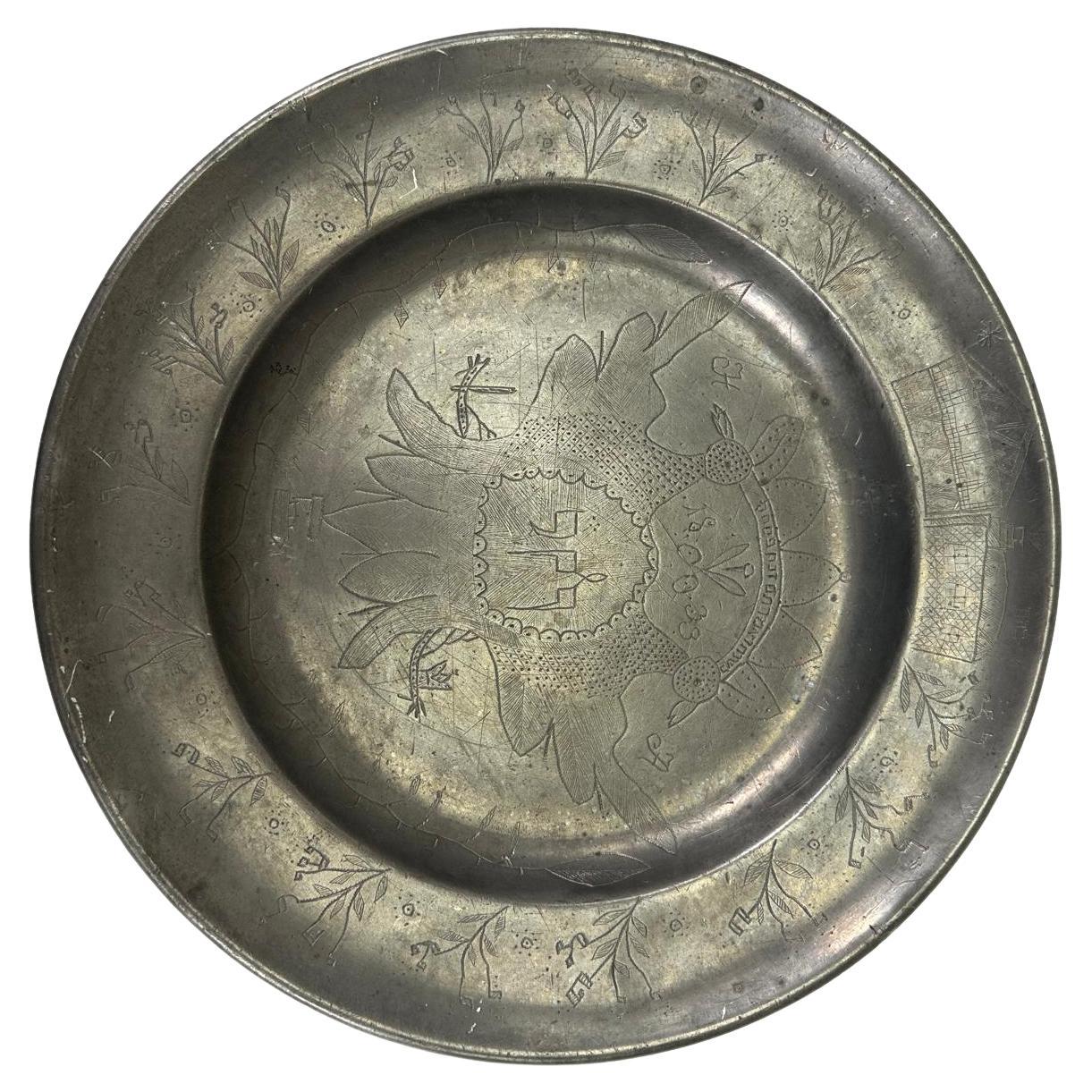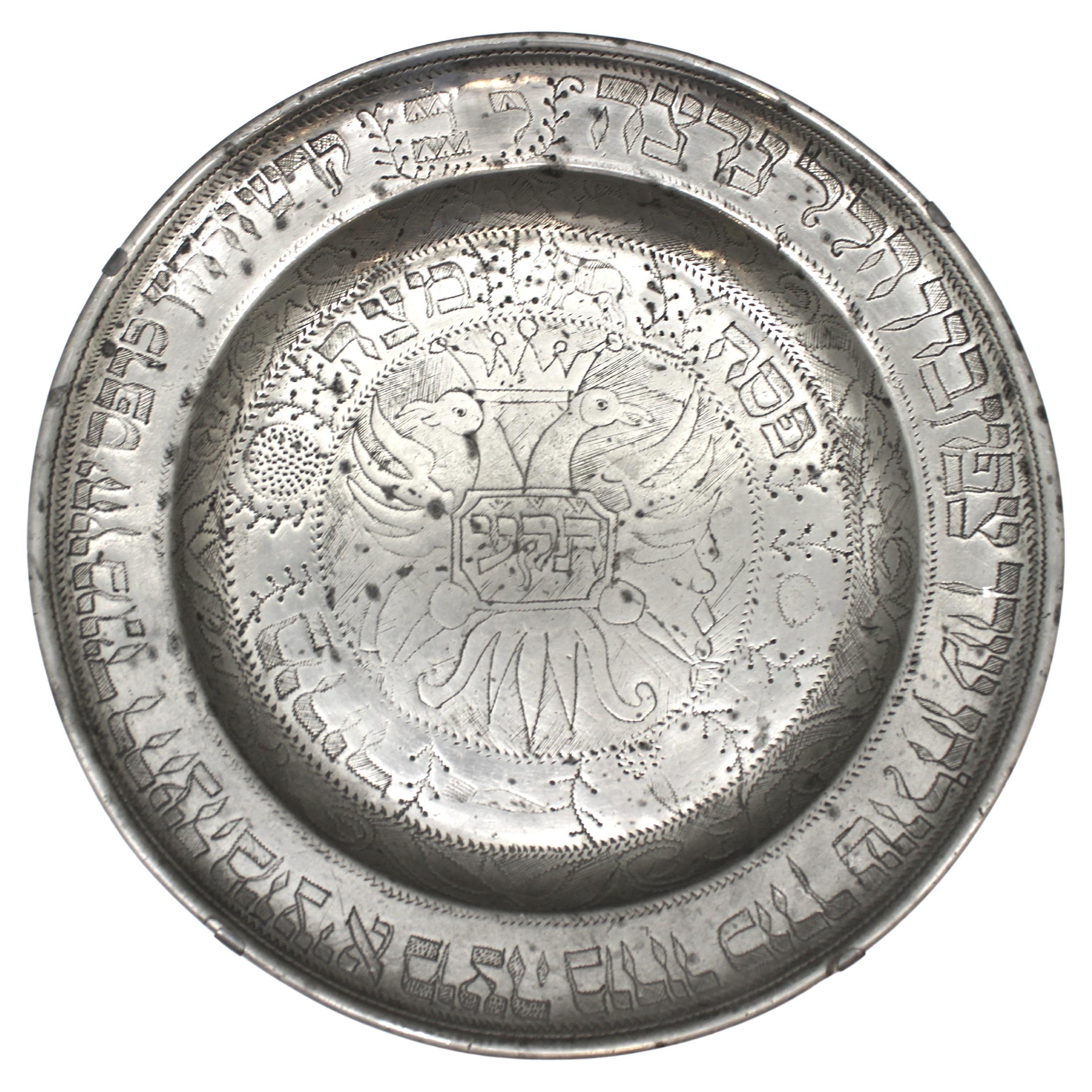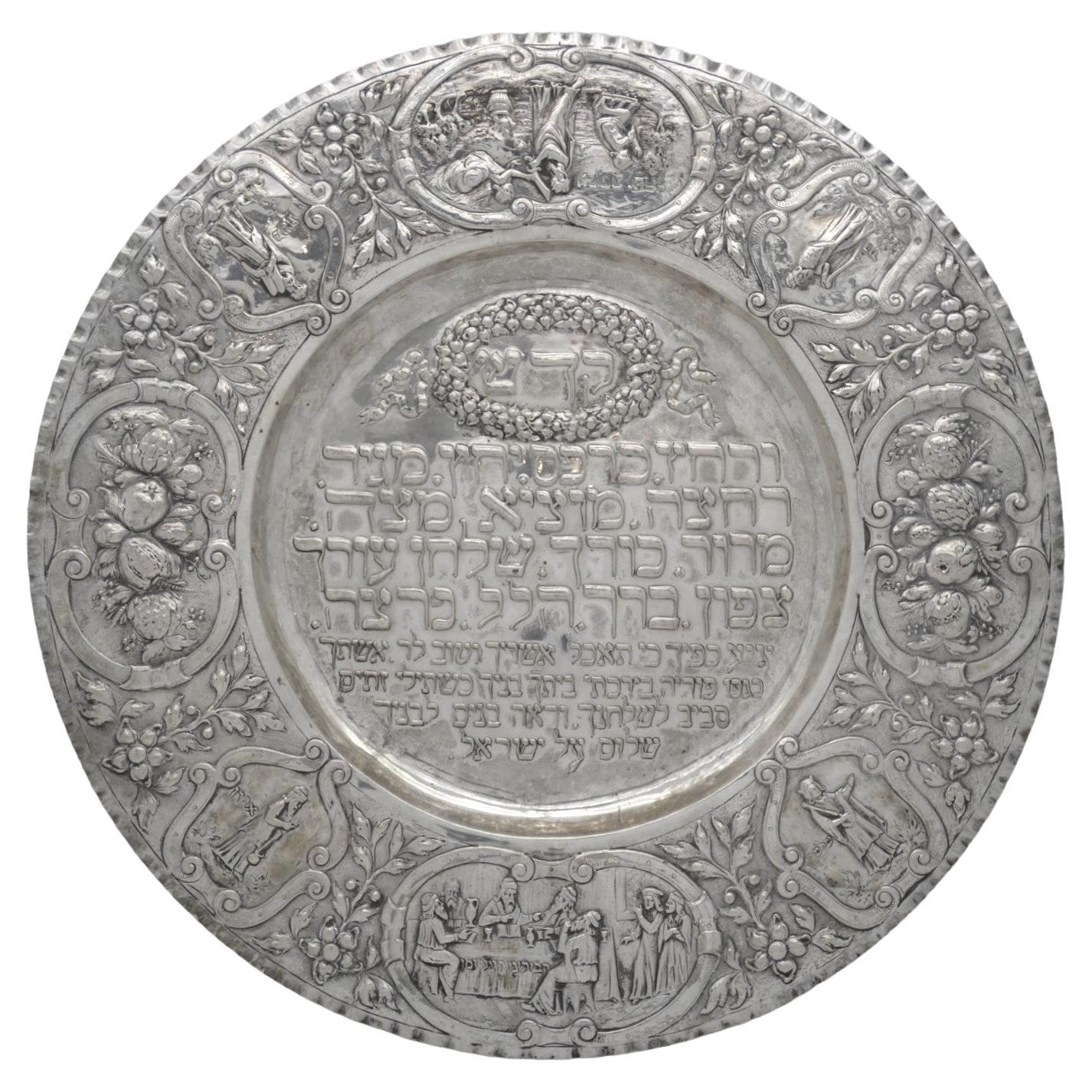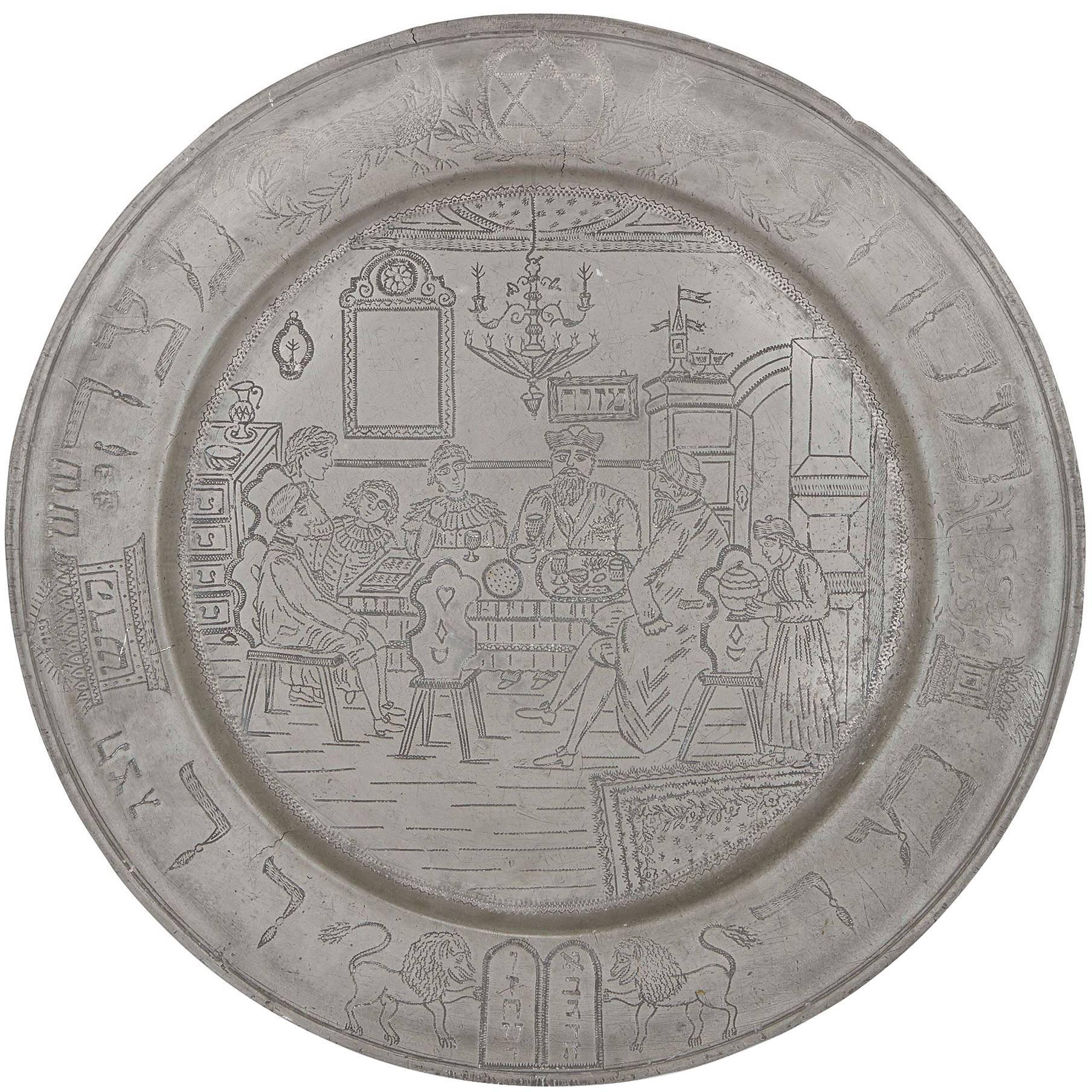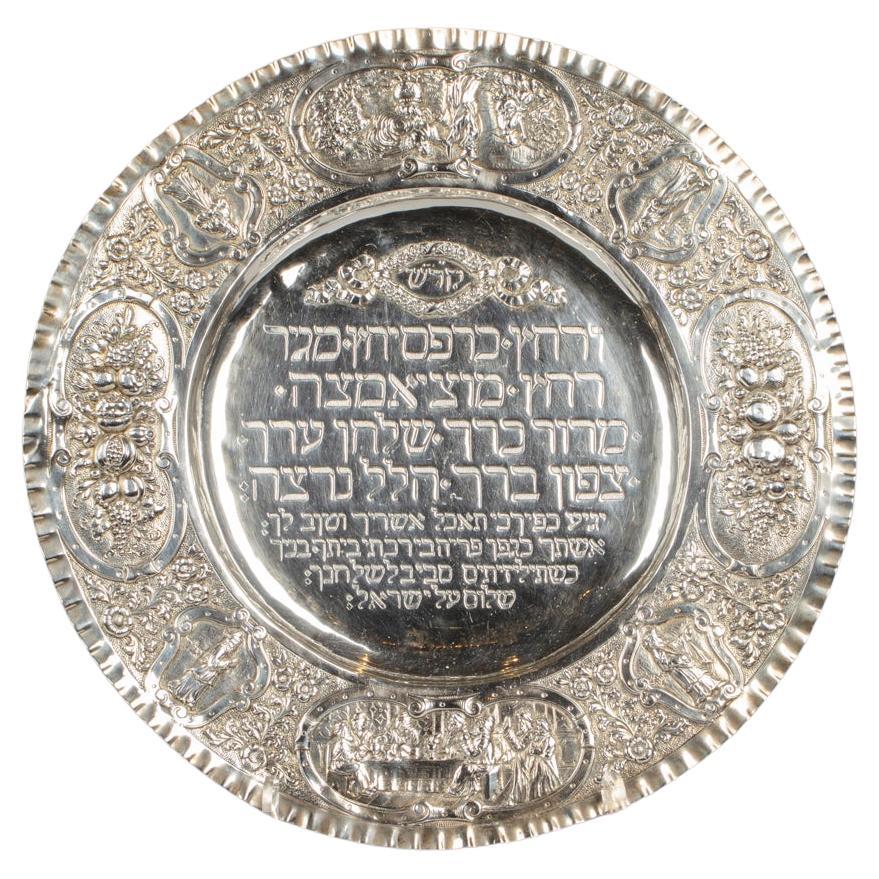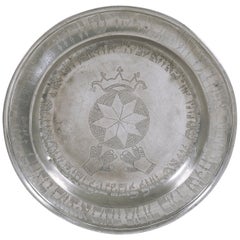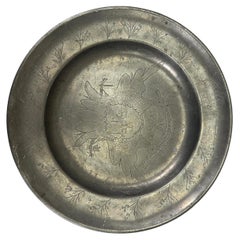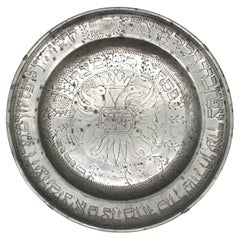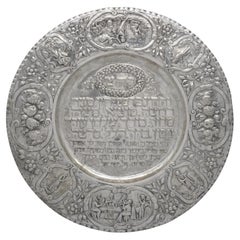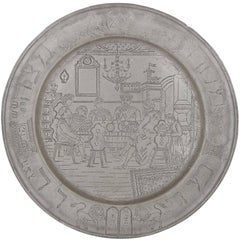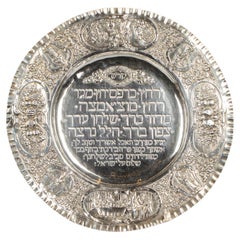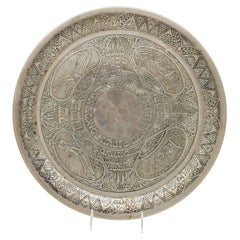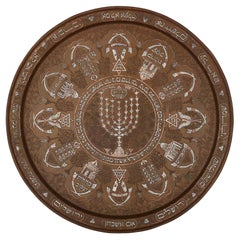Items Similar to 18th Century German Pewter Passover Plate
Want more images or videos?
Request additional images or videos from the seller
1 of 9
18th Century German Pewter Passover Plate
$6,600
$8,25020% Off
£5,011.54
£6,264.4220% Off
€5,731.07
€7,163.8320% Off
CA$9,221.16
CA$11,526.4520% Off
A$10,255.94
A$12,819.9220% Off
CHF 5,355.33
CHF 6,694.1720% Off
MX$124,803.87
MX$156,004.8420% Off
NOK 68,395.77
NOK 85,494.7220% Off
SEK 64,143.17
SEK 80,178.9620% Off
DKK 42,773.14
DKK 53,466.4320% Off
Shipping
Retrieving quote...The 1stDibs Promise:
Authenticity Guarantee,
Money-Back Guarantee,
24-Hour Cancellation
About the Item
Pewter passover tray, Germany, 18th century.
The outer rim has wriggle- work engraving of the order of the Seder service, along with a pair of birds flanking two Hebrew letters, which are the initials of the owner of the tray. Inner rim has two crowned lions (likely symbolizing Lions of Judah), two birds, and a deer. Below them it states “Seven days you shall eat Matzah” (Exodus 12:15), and “Passover Matzah Bitter Herbs”.
This tray is quite charming in the naïve workmanship of the engraving, particularly those of the animals depicted. The bodies of the lions and deer are wildly out of proportion, indicating that this tray was not engraved by a professional artisan, rather by someone who has no refined artistic
abilities, and is self-taught. For the Folk Art enthusiast!
Provenance: Dr. Jesse Greenberg, Englewood New Jersey.
- Dimensions:Height: 1.58 in (4 cm)Diameter: 15.75 in (40 cm)
- Materials and Techniques:Pewter,Engraved
- Place of Origin:
- Period:
- Date of Manufacture:circa 1780
- Condition:
- Seller Location:New York, NY
- Reference Number:1stDibs: LU5281219219032
About the Seller
5.0
Recognized Seller
These prestigious sellers are industry leaders and represent the highest echelon for item quality and design.
Established in 2006
1stDibs seller since 2020
130 sales on 1stDibs
Typical response time: 1 to 2 days
- ShippingRetrieving quote...Shipping from: New York, NY
- Return Policy
Authenticity Guarantee
In the unlikely event there’s an issue with an item’s authenticity, contact us within 1 year for a full refund. DetailsMoney-Back Guarantee
If your item is not as described, is damaged in transit, or does not arrive, contact us within 7 days for a full refund. Details24-Hour Cancellation
You have a 24-hour grace period in which to reconsider your purchase, with no questions asked.Vetted Professional Sellers
Our world-class sellers must adhere to strict standards for service and quality, maintaining the integrity of our listings.Price-Match Guarantee
If you find that a seller listed the same item for a lower price elsewhere, we’ll match it.Trusted Global Delivery
Our best-in-class carrier network provides specialized shipping options worldwide, including custom delivery.More From This Seller
View All19th Century German Pewter Passover Plate
Located in New York, NY
German Passover Pewter plate dated 1825.
The plate with raised rim engraved in Hebrew with the Order of the Seder of Passover, In center, geometric design, surrounded by Hebrew text...
Category
Antique 1820s German Religious Items
Materials
Pewter
$6,960 Sale Price
20% Off
1833 German Pewter Passover Plate – Rare 19th-Century European Folk Art Judaica
Located in New York, NY
This pewter Passover plate, dated 1833, is a rare and exceptional example of 19th-century European Jewish folk art. Crafted in Germany, it featur...
Category
Antique Early 19th Century German Religious Items
Materials
Pewter
A German Pewter Passover Plate, Circa 1810
Located in New York, NY
This charming and historically significant German pewter Passover plate, crafted circa 1810, is a poignant example of early European Judaica crea...
Category
Antique 1810s German Religious Items
Materials
Pewter
A Large Silver Passover Seder Plate by Gutgesell Gebrüder, Hanau Circa 1915
Located in New York, NY
A Large Chased Silver Passover Seder Plate made by Gutgesell Gebrüder in Hanau, circa 1915, is a very noteworthy piece of Judaica. Most seder plates were made with a cast and mass-pr...
Category
Early 20th Century Sterling Silver
Materials
Silver
$6,400 Sale Price
20% Off
Mid-19th Century Syrian Kabbalistic Copper Plate – Handcrafted and Engraved
Located in New York, NY
This intricately engraved copper plate from mid-19th century Syria is a remarkable example of Kabbalistic artistry and spiritual symbolism. Featuring finely inscribed Hebrew letters,...
Category
Antique Mid-19th Century Syrian Religious Items
Materials
Copper
An Italian Silver Passover Seder Plate, Venice Circa 1800
Located in New York, NY
This magnificent Italian silver Passover Seder plate, crafted in Venice circa 1800, is a striking example of refined silversmith artistry combined with deep ritual significance. Made...
Category
Antique Early 1800s Italian Sterling Silver
Materials
Silver
You May Also Like
Large and Impressive German Antique Finely Engraved Judaica Pewter Seder Plate
Located in London, GB
The fine German antique pewter plate depicts a family scene, as the group sits at the table during the Passover Seder. Around the rim of the plate...
Category
Antique 19th Century Religious Items
Materials
Pewter
German Silver Seder Plate, Early 20th century
Located in New York, NY
The well embossed with Hebrew blessings, the wide border with two large quatrefoil panels with scenes of the sacrifice of Isaac and the Five Rabbis of Benei Brak, alternating with tw...
Category
Early 20th Century Sterling Silver
Materials
Silver
Decorative Judaica Passover plate by Heinrich Schwed. Munich, 1924.
Located in Tel Aviv - Jaffa, IL
Decorative Passover plate by Heinrich Schwed. Munich, 1924.
ALPACA, etched.
This Large plate, featuring a round medallion in the center, with a Matzah which in this plate is hand c...
Category
Vintage 1920s Platters and Serveware
Materials
Alpaca
Large and Very Rare Silver-Inlaid Antique Judaica Tray
Located in London, GB
A large and very rare silver-inlaid antique Judaica tray
Jerusalem, c.1900
Height 2.5cm, diameter 62cm
This large and remarkable work is a copper and silver-inlaid antique Jewish tray, featuring meticulous and exceptional metalwork, and was made in Jerusalem around the turn of the twentieth century.
It features a twelve-fold repeating pictorial decoration, which is set between two circles, that of the central ring in which a large menorah...
Category
Antique Early 1900s Israeli Modern Religious Items
Materials
Silver, Brass, Copper
Rare early Bezalel Jerusalem JUDAICA etched brass garden of eden plate
Located in Tel Aviv - Jaffa, IL
very rare Bezalel Jerusalem plate , this amazing plate has the best subject And artistic Design i have seen in a lot of years, the plate has 5 different scenes from the story Of Adam And Eve in the garden pf Eden.
On the middle of the plate the is an Hebrew inscription, it is parts from the 5 lines that describe The 5 scene on the plate:
"וַיִּ֩יצֶר֩ אֶת־הָֽאָדָ֗ם עָפָר֙ מִן־הָ֣אֲדָמָ֔ה"
"And the Lord God formed man of dust from the ground"
"לֹא־ט֛וֹב הֱי֥וֹת הָֽאָדָ֖ם לְבַדּ֑וֹ"
"And the Lord God said, "It is not good that man is alone"
"'וַיִּֽהְי֤וּ שְׁנֵיהֶם֙ עֲרוּמִּ֔ים"
"Now they were both naked"
"וַתִּקַּ֥ח מִפִּרְי֖וֹ וַתֹּאכַ֑ל וַתִּתֵּ֧ן גַּם־לְאִישָׁ֛הּ"
"She took of its fruit, and she ate, and she gave also to her husband"
"וַיְגָ֖רֶשׁ אֶת־הָֽאָדָ֑ם וַיַּשְׁכֵּן֩ מִקֶּ֨דֶם לְגַן־עֵ֜דֶן אֶת־הַכְּרֻבִ֗ים וְאֵ֨ת לַ֤הַט הַחֶ֨רֶב֙ הַמִּתְהַפֶּ֔כֶת לִשְׁמֹ֕ר אֶת־דֶּ֖רֶךְ עֵ֥ץ הַֽחַיִּֽים:"
"And He drove the man out, and He stationed from the east of the Garden of Eden the cherubim and the blade of the revolving sword, to guard the way to the Tree of Life."
This rare plate is fully marked on the back "BEZALEL JERUSALEM" in Hebrew, the Jerusalem Mark is a bit worn but it is present, on the top of the mark there is the number 522 which is Probably the model number, this plate was mad on the early 1910s or even earlier and it is one of Bezalel earliest works, it is not known who is the artist but the artistic style is typical of Reuben Leaf Lipschitz, he was working in Bezalel in 1912-1916 and was the manager of the etching Department in this time frame, in 1916 he moved to the USA to escape joining the ottoman army in ww1. he stayed in the USA and became a graphic designer who designed and decorated Synagogues he also made graphic designs a illustrations to Hebrew books...
Category
Vintage 1910s Israeli Arts and Crafts Decorative Dishes and Vide-Poche
Materials
Brass
18th Century Pewter Plate With Important Coat Of Arms, dated 1721
Located in Bilzen, BE
18th century pewter plate dated 1721 and engraved with an important coat of arms.
Makers marks on the back
Diameter, 23.8 x 23.7 cm.
Category
Antique 1720s Belgian Louis XV Historical Memorabilia
Materials
Pewter
More Ways To Browse
Furniture German 18th Century
German Crown
German Service
German Pewter
Pewter Plate
German Religious Collectables
Antique German Pewter
Crown Religious
Deer Plates
Engraved Pewter
Antique Pewter Plates
German Plated Tray
Pewter Tray
Antique Pewter Collectables
Antique Pewter Tray
Pewter Lion
German Pewter Plate
Seder Plate

